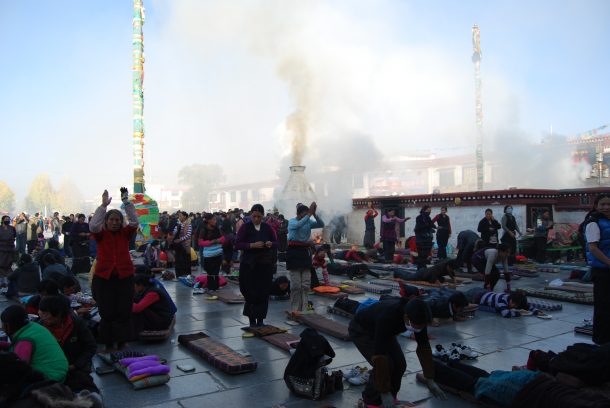7 Things You Must See and Do During the Tibetan New Year

Right now, if you walk through the streets of Lhasa, you will see Tibetans everywhere carrying wooden buckets full of different grains and yak butter. On this third day of the Tibetan New Year or “Losar,” these buckets or “Qemar” are given to friends and family to symbolize a good harvest. During this time of the year, Lhasa is at its all-time peak in terms of activities and is one of the best opportunities to witness Tibetan culture at its finest.
Losar is one of Tibet’s oldest festivals, predating the arrival of Buddhism in the region. It originated from a winter ceremony during the Bon period, in which people would burn incense to appease deities and local spirits. Today, Losar is celebrated as a Buddhist festival during the first lunar month of the Tibetan calendar, usually in February.
Lasting for 15 days, this festival covers an impressive spectrum of activities and traditions you won’t want to miss.
Table of Contents
1. Traditional Tibetan Fashion
As an essential custom of Losar, Tibetans put on new clothes for the New Year. On the streets, in their homes, and at temples, Tibetans everywhere will be donning their finest traditional clothes. Each region of Tibet has its unique style of dress, so in Lhasa, you’ll get a real sense of just how diverse the people are.
2. Try a Guthuk
On Tibetan New Year’s Eve, families gather around the table and eat Guthuk, a small dumpling stuffed with different items. Each item represents something different about the recipient’s personality or future. For example, guthuks may be loaded with coins to symbolize good fortune. If your guthuk is stuffed with chili, it means you tend to speak harsh words.
3. Attend a Buddhist ceremony
In the past, the second day of the Tibetan New Year, Gyalpo Losar, is the day to pay tribute to kings or leaders of society. Today, pilgrims from all over Tibet flock to Lhasa to offer the monks gifts and participate in purification ceremonies.

4. Butter Sculptures
Toward the end of the Losar celebrations, monumental butter sculptures are unveiled at local temples to mark the Lord Buddha’s victory over his six non-Buddhist teachers in a contest of performing miracles. It takes a team of monks several months, in freezing conditions, to complete a single butter sculpture. Head to Bakhor street at night for the best display of butter sculptures.
5. Drink Chang
Chang is a traditional Tibetan beer brewed from barley and is served hot during Losar Festival. The alcohol content is relatively low, but it gives the drinker a balanced warm feeling and is excellent at helping ward off the cold.
6. Watch a Tibetan Dance

Besides the title of “The Roof of the World,” Tibet is also known as “The Ocean of Songs and Dances.” During festival time, Tibetans are known to dance from sunrise to sunset in their traditional dress. Imagine how many dances there will be during Tibet’s most important festival!
7. Witness the Changing of the Prayer Flags
In Tibetan culture, prayer flags were initially being used as talismans to protect warriors in battle. Today they are regarded as a symbol of peace. Tibetans like to hang them in clean windy places like rooftops and hills, and every Losar, the flags are changed to signify a new beginning. The most elaborate flag-changing ceremony takes place outside Jokhang temple, where dozens of people are required to change the five lines of prayer flags together all at once.

Recent Posts
Exploring the Beauty of Tibetan Handicraft
The Ultimate Guide to Tibet Tours, Travel, and Trekking Adventures
How to Explore Tibetan Culture
All Categories
- About Tibet
- book a Tibet tour
- Buddhism Practice
- Budget Tour
- China-Tibet Train
- Customized Tibet tour
- Historical Sites
- Hot Springs in Tibet
- News
- Photography in Tibet
- Tibet attraction
- Tibet Group Visa
- Tibet Motorcycle Tour
- Tibet Small Group Tours
- Tibet Tours and Tibetan Tour Guide
- Tibet Train
- Tibet Travel FAQs
- Tibet Travel Information
- Tibet Travel News
- Tibet Travel Permit Update
- Tibet Travel Prices Rises
- Tibet Trek
- Tibet Trekking Tour
- Tibet weather and climate
- Tibet Wildlife animals
- Tibet Winter Tour
- Tibetan Buddhism
- Tibetan Cultural Features
- Tibetan Culture and Poeple
- Tibetan Festivals
- What to see in Tibet



